Golden Demon 2014 is going to take place this weekend! The only edition this year of our beloved glorious contest, and we have to cherish it! To anticipate and celebrate at the same time, today I bring you the last of the interviews to Slayerswords of 2013. This one was conducted quite some time ago (some of the questions you will see are now a bit senseless, because we know there will be no more GDs this year for example). It is true that it has taken me a huge time to finish (I translated it into Spanish for my fellow clansmen) but it has been worth every second of my translating. Probably the best interview I have had the chance to read in my blog, absolutely inspirational and interesting, I hope you receive the same feeling of motivation that I got from his words. Without further ado, today I bring you Thomas Ales, Slayersword USA 2013.
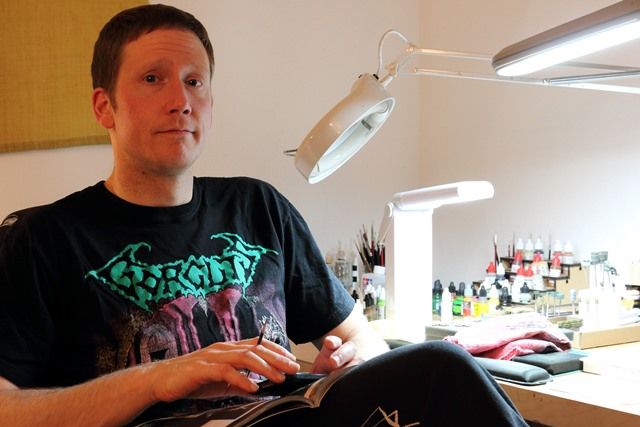
Volomir: How long have you been painting miniatures? Tell us a bit about yourself.
Thomas: Hmmmmm… a bit about myself… well, I’m 37 and a native of the frozen wasteland that is Wisconsin. During my daily life I work for a Corporation managing intellectual property estates (patents, etc.) and my educational background is in Chemistry and Physics. In my free time, of course I love to paint and hobby, and am a lifelong nerd. I am an avid comic reading, anime watching, sci-fi/horror loving, and death/black metal listening, average kind of guy.
I have been painting miniatures on and off since the mid to late 80’s. My first memories of miniatures were Dungeons and Dragons minis that I believe I still have in my basement somewhere. My first vivid memory of miniatures was when Warhammer 40k first became available state-side. I was about 12 at the time when I went into my local hobby shop and saw the original Rogue Trader Space Marine box set and from then on I was hooked on the hobby. As much as I appreciated playing the game, I found building, converting, and painting to be much more enjoyable.
Over the years I stayed in touch with the hobby as much as possible, but school and work demanded most of my time. I remember having time off from school and breaking out some paints and slowly getting back the basic skills, right before I would return to school. Around 2007, I started buying more minis and spending more time painting, but really focusing on table top level. In late 2010 I had a “life event” that really made me want to pick one hobby and focus on it; and the winner was painting miniatures. In 2011, I started working much harder on display level miniatures.
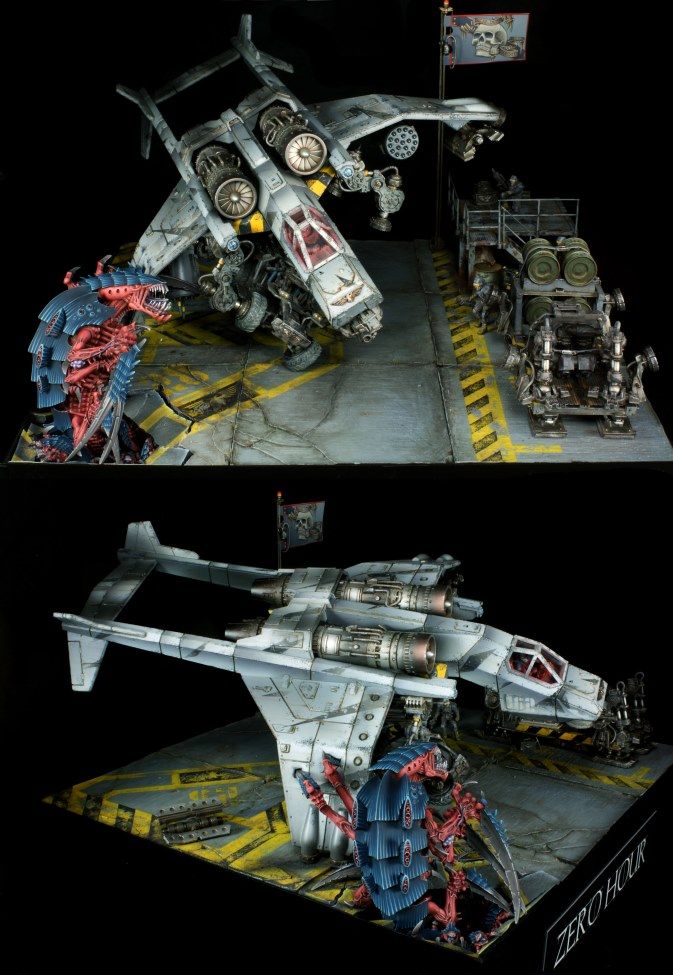
Volomir: What drove you to paint miniatures?
Thomas: I feel what drove me to miniature painting was my lifelong love of dioramas and any small scale rendering. When I was a kid, my parents hated taking me to any museum with dioramas. They could not pry me from the display cases. In addition, I think I watched the making of Star Wars (the scenes of the scale model building and filming) a couple hundred times. Ray Harryhausen was a profound influence on my love of the hobby. His innovated approach to stop motion special effects using miniature figurines (with fully posable armatures) created several movies that I watched over and over as a child (Clash of the Titans ‘81, Jason and the Argonauts, 20 Million Miles to Earth, numerous Sinbad movies, etc.). If you ever have a chance to watch a documentary on Harryhausen, I highly recommend it. His passion for his work and ingenuity were an amazing inspiration to me.
When I was old enough to start to “create” my own miniatures, I did not need much motivation. With each set of miniatures I would buy, there were seemingly endless number of combinations, modifications, and colors I could apply. The hobby just started growing at that time in the US (late 80’s), so it seemed there was a new kit available every week. When the first Citadel™ painting guides and White Dwarf™ magazines started appearing with some of the most amazing paint jobs, I would sit and read and reread them and try to make my minis look that good. My numerous failures kept me motivated for sure. Every time I came back to the hobby I would buy a new magazine and see how styles had changed, and how much more elaborate miniature painting had evolved. I also realized that I had a new standard to measure up to. The constant improvement in the painting community was another inspiration and challenge that drove me to keep painting. Lastly, as the hobby moved more online, the amount of sharing and collaborating is amazing. The info online for painting is endless and it is awesome to get a perspective on a technique or effect that you would not otherwise have access. This info sharing always keeps me inspired to try something new.
Volomir: Are you professional or is it a hobby for you?
Thomas: This is purely a hobby for me. I would love to do it professionally, but I have learned over the years that when you make something your job, you run the risk of not enjoying as much. So at this point, I am happy spending my free time painting. I guess if I found the right opportunity I would seriously consider a change. I have followed the hobby for far too long to not consider it professionally.
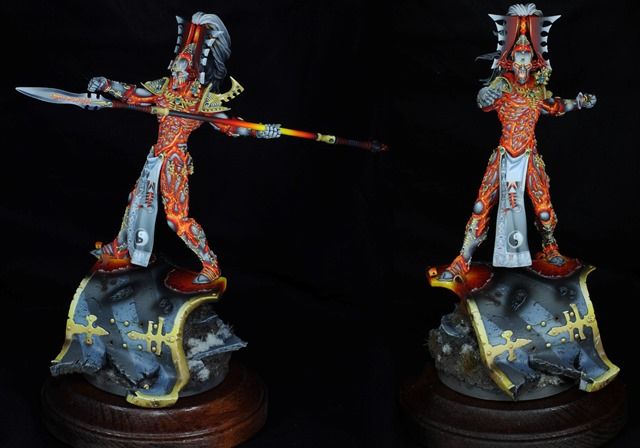
Volomir: Can you tell us something about the painting community in the US? Is it small or big? How's the level of the painters? And the miniature hobby, is it widespread?
Thomas: Obviously, the size and popularity of the painting and miniature hobby in the US is relative to where you live. In mid/northern Wisconsin, it’s no surprise it is a very niche hobby, but the local game shops attract quite a few people from other areas. As for painting in my area, most are interested in army and table top level painting and not display level painting. As you go into the larger cities, just by virtue of a larger population, you have more interest in the hobby. Adepticon 2014 attracted a couple thousand attendants to the Chicago area and the Crystal Brush painting competition had a couple hundred entries across the categories. I personally felt the painting level at the Crystal Brush was very good. Several of the well-known award winning US painters (and a few Europeans) showed up to compete making it a very fun and challenging event.
Volomir: Do you see big differences in the painting style and level of the US community and Europe in general?
Thomas: I will only comment on my style and level. I am older now and have a good amount of humility, so I see many differences in my style and level compared to many in the European community. I personally feel that my style is a bit flat at times and needs more contrast and character. I am a very technical painter so I am continuing to focus these fundamentals as well as composition. European painters have an excellent sense of pulling a lot character and feeling into their miniatures while balancing composition. This is the most difficult part of the hobby and it why I want to take risks and challenge myself going forward. When I made up my mind to start painting more for competition, I knew if I wanted to do my best and be happy with my results that it would take several years of hard work.
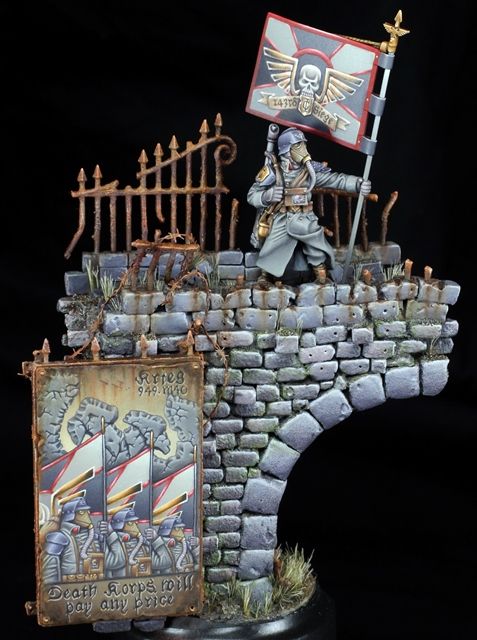
Volomir: How was winning the Slayer Sword for you? How did you feel? Have you noticed any difference in your painting life since you won?
Thomas: It was very exciting and surprising. I worked very hard over the year leading up to the event with a personal goal of having all of my entries make the first cut. I had a stretch goal of placing in one category; again I was very surprised at the results.
Since I won, I am inspired to try even harder and take on more challenges with my painting. I now feel that if I were to pick up a miniature and know exactly how I am going to paint it, I am not painting outside of my comfort zone and not challenging myself. I took a lot of risks with my Slayer Sword entry and it worked out, many will not, but I will continue to learn and grow as a painter. I want to continue painting miniatures that I am passionate about regardless of how tough or light a prospective competition category. If I am not excited to paint something or if I don’t have a good background story for a piece, I know I will not put all my effort into the piece.
Also, being newer to the US painting scene I felt a little weird after winning. I was aware of some comments online about the decision but I never heard any specifics. When I attended the 2014 Crystal Brush, I did not know what to expect from the other painters. But after the weekend, I met a lot of other great painters, made a bunch of new friends, and got some great feedback on my minis. Going forward, I am excited to attend events and get together with the other painters.
After reading several blog posts by Enrique Velasco (emuse) and your interview with Martin Goumaz, I was surprised at their comments on how their painting communities react to winning awards. If I had to paint with that type of criticism, it would be very demotivating. I am very proud to participate in competitions like the Crystal Brush after reading emuse’s comments on the event. All of the US painters are very friendly, sincere, respectful, and are happy to get together and talk about the hobby.

Volomir: How did you come with the idea of the Ork idol that won the Slayersword?
Thomas: I was inspired by the story and background of the idol mostly, not the Warhammer Forge mini. If you look over the background and pictures of the idol in the Monstrous Arcanum, you will see where I got my inspiration. When I heard that ForgeWorld was going to be making a mini, I was really excited. When it was released, I was not as thrilled (no offense to Mark Bedford the designer), but I still saw a lot of raw potential in the mini. My only goal in painting the mini was to “make it cool”; I never imagined it to be a winner.
Specifically speaking to the features I added versus the story of the idol, I made a lot of modifications. The idol is referred to as rogue since the shamans conjure up a little magic and put the idol into battle. The idol then destroys anything in the path until they run out of Orc mojo. I felt I could build a side story out of it by seeing what an Orc idol would look like if it was not a rogue, which was the inspiration behind adding the top and rear howdahs. There is a goblin shaman in the top howdah that is in direct control of the idol using his magic to influence how the idol battles. Of course there is a team of gretchins to help with the miscellaneous, battle music, fixing the howdah and fending off brazen enemies.
Another personal challenge to the piece was trying to incorporate a lot of different materials and techniques. The rock surface was created using a combination of acrylics, enamels, pigments, and oils. The glowing mask was a combination of airbrushing and brushing with acrylic inks and paints. The howdahs are constructed from basswood and colored with a myriad of alcohol based stains and enamels and weathered with pigments to add a dry rot, moldy effect. There are roughly 30-40 chains using around 60-70 bolts driven into the stone to hold the howdahs and weapons in place. I used about 90% of a full package of grass tufts (several colors) with various roots and dirt added to the surface and crevasses. And I believe I sacrificed about half of my brain cells smelling super glue while adding the grass!
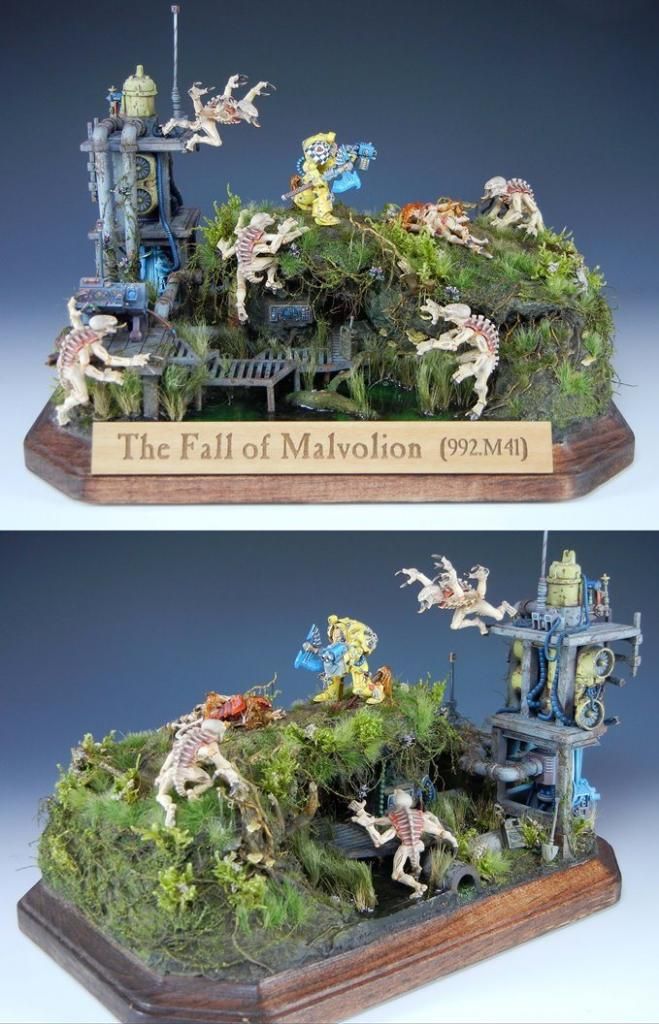
Volomir: Do you think there will be a GD US in 2014? What's your opinion on how GW is dealing with GDs lately?
Thomas: At this point of the year, I have lost faith that there will be a GD US 2014. It is unfortunate, but it is out of my control so I can’t get frustrated or demotivated by it. I hope to see a return in future years but GW as a company with shareholders has to make money. I work for a large publically traded company so I understand decision making guided by financials. If they found GDs to lose money, I understand their reasoning, but any company can benefit from advertising and marketing, even if it is at a short term loss. I find it hard to believe that the GDs affected GW’s bottom line significantly, and GDs are/were great advertising and marketing. In comparison, very few music acts that tour make money, most lose in then end. But the brand and following they build pays back for years and years. GW has (or had) a loyal fan base that loved GDs, they are losing a lot of brand equity by not continuing with these in the future. As a publicly traded company, I find their lack of transparency to be surprising at times. I think they would do much better for themselves if they communicated more with the fans, and frankly, showed an ounce of love to their loyal buyers. Even the most loyal can move on. But, they still have awesome intellectual property in WFB and 40k and they still make some killer minis and kits. I am sure I am going to catch some flak for that comment ☺
Volomir: Any artists that influence your painting? What are your favourite painters of all time?
Thomas: There are several artists that influence my painting, especially outside of the miniature painting arena. I mentioned Ray Harryhausen of course. In the realm of comic books, Jack Kirby was one of my favorite artists when I read my dad’s comics growing up. He is one of the first comic artists that most accurately captured action sequences in a static two dimensional drawing. Dan Seagrave was an artist that I grew up with as well. Dan Seagrave defined the US and European Death Metal album cover in the late 80’s and early 90’s with unbelievably detailed and dark works of art. I highly recommend checking out his work.
As for favorite miniature painters, there are several, but ones that come to mind first would be Francesco Farabi, Raffa Picca, Aaron Lovejoy, and Sam Lenz. Francesco’s freehand is something that inspired me to start working harder in this area. I have a loooooooooong way to go to catch up to Francesco. Francesco creates a work of art inside of a work of art without it being too “busy”. Raffa has an undeniable grasp of composition and color and he can weave a lot of story into small pieces. Seeing “Touch of Death” in person was an honor at the 2013 Crystal Brush in Chicago. Aaron Lovejoy puts an incredible amount of character and color into his minis. I often look up Aaron’s work for inspiration. More specifically, the mini “The Masque of Slaanesh” is one of my favorites and is the reason I love the color purple. Sam Lenz is a great friend and painting brother that also endures the frozen tundra of Wisconsin. He is an amazing painter that has imparted an immense amount of advice and knowledge on to me over the past several years. Sam and I get together regularly and talk through ideas and paint jam. A lot of this time is what I attribute to evolving and growing as a painter.
As for an all-time favorite miniature painter, it would be Ben Komets. Ben has had been a profound inspiration for me and I have always admired his ability capture as much reality as fantasy/sci-fi in his works. He has an amazing ability to balance colors and contrast to avoid over emphasizing aspects of the miniature. When I look at his work, I feel like I am standing off to the side and seeing this scene or character in real life, I hope that makes sense. He is not afraid of larger pieces with multiple components and complex composition. This is something that I strive for in my pieces going forward. The pieces that he creates, I personally think, would communicate well in all forms of media. “Thron”, “General of Khorne on Juggernaut” and “The Last Survivor” are some of my favorites. I was honored to meet him at GD US 2013 and see his work first hand; especially his diorama entry “Tau New World Order”.

Volomir: Do you attend other painting events apart from Golden Demon?
Thomas: Yes, I am very lucky to live near to the Chicago area where in April every year is a very large gaming event called Adepticon. Within the gaming event, CoolMiniOrNot hosts the Crystal Brush painting competition. Crystal Brush is still a newer event, but I think it has the potential to fill the void for Games Day and become one of the best competitions in the US. I have attended the Crystal Brush since 2012, but only entered pieces in the last two events. I am looking forward to many more.
Unfortunately, unlike Europe, there are not a lot of options for miniature and painting events throughout the year. Later in the summer, GenCon and Privateer Press have competitions in the Indiana area, but I have yet to attend this event. Again, I look forward to it in the future. I would love to attend a Euromilitare or Hussar at some point in my life as well.
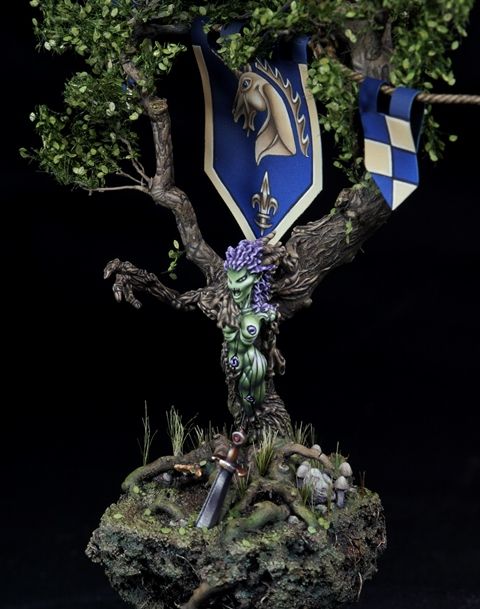
Volomir: Any advice you want to give newcomers to the miniature painting world?
Thomas: Confidence! That is the one word sage piece of advice I got from a fellow painter when I started painting more for competition. The only way you build confidence is with time behind the brush and being honest with your work. Being your own worst critic is not a bad thing. When you hold a finished piece up to another, be honest with where you think you need to build some skills or learn a new technique. Build confidence by not being afraid to ask questions and make sure to ask fellow painters for feedback.
Also, you can never lose by seeing a different perspective. Every time I buy a new book or DVD, or read a blog, I try to review all of the info included, including the basics. I always see different ways to accomplish the same steps in a project (e.g., a new tool, a new way to hold tools, new materials, different brush techniques, color combinations, different orders of operations, etc.). Whenever I attend classes, I always listen very carefully for the instructor’s interpretation of a technique, style, etc. Everyone processes information differently and you live in a sad world if you think your way is the only way and the right way. The combinations of techniques, tools, materials, colors are endless, and therefore you will always have a challenge ahead of you. Often I hear one phrase that makes me think differently about how to approach a miniature or component of a piece.
Seriously guys, I can't stop thinking about my next projects after reading this huge inspirational piece of knowledge. Thanks so much Thomas! I hope that you keep following your path to enlightment, you are doing a great job so far! And please tell us all about it!

3 comments:
Two Bruddhas one Interview. No Cups :D
Great interview, guys!
Really great interview. It's always great to see the perspectives of artists, because this work is definitely art!
Thank you so much for taking the time to put this up - a great interview from a humble and inspiring artist!
Post a Comment